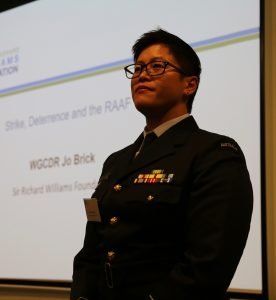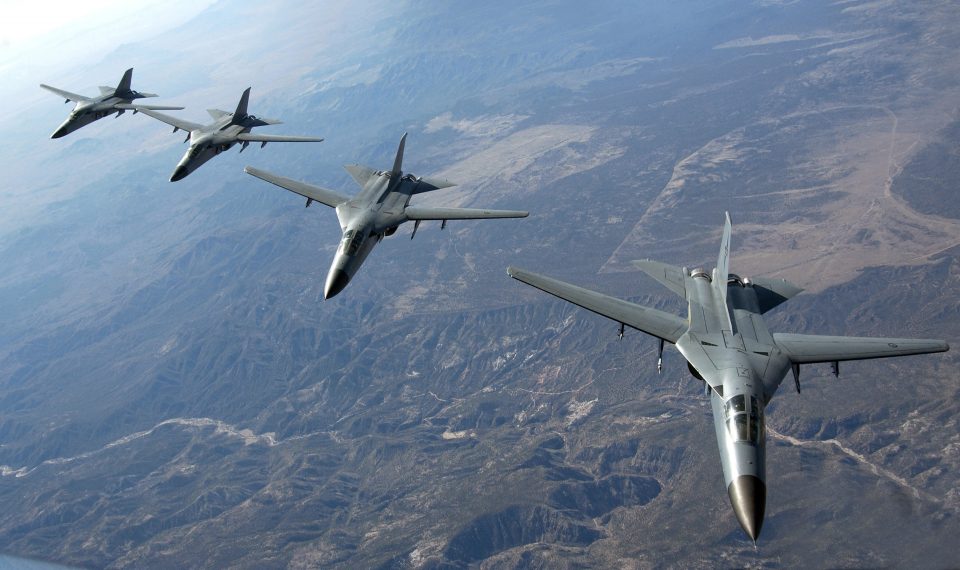By Robbin Laird
The Williams Foundation seminar on joint strike and deterrence was led off by a presentation by Wing Commander Jo Brick.
The WGCDR focused on looking back at the experience of the RAAF in the strike domain historically and then posing questions about the way ahead for the RAAF within a joint force.
What is the role of joint strike in an Australian deterrent strategy?

She started by providing an overview of how she saw the context and the challenge for Australia today.
Since the advent of air power in the early 1900s, the threat of bombardment – both nuclear and conventional – has been perceived as one of the most effective measures for deterring potential aggressors or punishing those who have dared to cross the threshold of force.
Deterrence is broadly defined as ‘discouraging states from taking unwanted military actions,especially military aggression’.
The strike capability that is offered by air power as a result of its characteristics – reach, responsiveness, firepower, and precision – and have made it a useful means by which to assert a deterrence strategy.
Notably, much of the discussion in the 1970s and 1980s focused on the central place of air power in delivering Australian strike capability. In relative terms, during this period, land and maritime forces were not seen to have a significant role in offering a deterrent strike option, though both of them did add toAustralia’s overall deterrence posture.
Further, much of the deterrence thinking during the Cold War focused on strategic nuclear options that were delivered via Intercontinental Ballistic Missiles or heavy bomber aircraft.
This again skewed much of the thinking regarding deterrence towards the primacy of strike via air power. The relatively favourable position occupied by Air Forces in this regard became a solid foundation for an independent Air Force that was not just an adjunct to the Navy or Army.
The end result of all these developments was a line of reasoning that inevitably fused deterrence with strike (bombardment) and air power.
This model was useful for Western countries during the Cold War, when there was a known threat – the Soviet Union –that could form the subject of detailed deterrence strategies; and when air power capability was the most appropriate option to support it.
The contemporary security environment offers a different set of challenges from the Cold War that arise from the changing character of war.
There are multiple, diverse, threats from both state and non-state actors; the information domain has become a vital part of the battlespace that must be managed accordingly; and there have been revolutionary developments in the means and methods of war.
This includes the increasing accuracy and range of weapon systems available to all the Services, the development of non-kinetic options that may also offer the same effects as traditional kinetic strike, and an integrated approach to warfare.
All these factors will require Australia to determine the kind of military posture that is required to maintain an effective and credible deterrence strategy in this context.
While deterrence and strike will continue to be linked, air power is unlikely to remain the primary provider, with greater emphasis being placed on the enhanced capabilities delivered by joint strike.
Further, as the lines between peace and war become blurred, strike as a deterrence option must be nested within broader conceptions of diplomacy and strategic engagement that accommodate ongoing shaping and influencing efforts, through effective management of the information environment, that form Australia’s narrative of deterrence.
During her look back, she addressed the role of the F-111 as well as thinking at the time of the acquisition of the F-111 with regard to nuclear weapons.
This was an especially important phase in Australian deterrent thinking because it combined the acquisition and operation of a long range-strike platform with considerations of nuclear deterrence as well, something which may clearly be on the agenda again for Australia.
During the late 1950s military strategic guidance asserted the prevalence of limited war over global war, and the need for Australia to develop military forces that could form part of an alliance or take independent action to defend Australia’s northern approaches against potentialaggressors.
Strike aircraft, for the purposes of deterrence, were central to this policy.
The Chiefs of Staff Committee at the time considered that China and Indonesia posed the likely air threat to Australia.
The Sukharno policy of ‘Confrontation’ towards the new state ofMalaysia also elevated the perceptions of the threat posed by Indonesia in the early 1960s. These factors led to policies that emphasised the need to deter such potential aggressors through the development of a strong air strike capability.
As a result, in 1963, the Menzies government ordered a number of ‘Tactical Fighter Experimental’ or ‘TFX’ bombers – later renamed the F-111, which remained the RAAF’s primary strike aircraft during the Cold War until its retirement in 2010.
Before the decision to acquire the F-111, tactical nuclear weapons for the Canberra bomber were also considered, but the option was shelved due to intelligence assessments that dismissed the possibility of nuclear attack on Australia as a primary target.
Further, reliance was placed on the nuclear umbrella provided by the United States under the ANZUS alliance.19 For the RAAF, the conventional bomber became the ‘strike force’ that was seen by the air staff as ‘the essence of deterrence’ and ‘the primary expression of military strength’.
Strike aircraft were necessary for seizing control of the air through destruction of enemy air forces on the ground, followed by the destruction of strategic targets, and then support to the Navy and Army.21
This doctrinal foundation was maintained throughout the 1980s and 1990s.
After having provided an overview on the past and the key role which strike aircraft have played on Australian deterrent thinking within an alliance with the United States, WGCDR Brick then considered the relevance of this narrative to the contemporary situation and shaping a way ahead for the ADF within an evolving Australian deterrent strategy.
The emergence of new security threats such as non-state actors, and the significance of information as the currency of the 21st century, means that approaches to deterrence must be reconsidered.
Credible conventional options for Australia go beyond air power, and require an effective and integrated joint force.
Communicating a credible message to opposing countries requires a consistent narrative that involves hard and soft power options and a consistent deterrence message that bridges war and peace.
These approaches to deterrence require Western countries, such as Australia, to take a long term and coordinated approach to national strategy, whose credibility is underwritten by a resilient and capable joint force.
Her focus was upon the importance of the joint force providing capabilities for the Australian government to be able to shape a variety of coercive or persuasive means against potential adversaries.
Although she did not put it this way, the key challenge of crisis management with peer adversaries has become a central one, and deterrent strategy needs to be built to allow Australia and her alliance partners to find ways to persuade authoritarian states that the risk outweighs the gains to engage in or continue challenging Australian interests.
She clearly has in mind the ADF shaping a much wider range of joint tools within its quiver to allow the Australian government to expand its options sets with regard to influencing adversary behavior.
Developments in military capability, including non-kinetic options such as cyber-attack, have provided the ADF with the opportunity to create integrated joint capabilities to support Australia’s deterrence strategies.
She then added her assessment of the Russian approach and its relevance to innovations in 21st century approaches to deterrence.
While deterrence has always been considered a whole-of-government strategy, the added complexity of the current strategic context requires us to re-consider the importance of all elements of national power.
An example of this is the holistic approach to deterrence that can be found in Russian strategic culture, which takes a ‘cross-domain’ approach to coercion thatis tailored for different actors.
What is interesting about the Russian approach is the significance that is accorded to the informational tools of influence, involving manipulation of an opponent’s perception of reality to impact on decision-making.
Termed, ‘informational struggle’, it involves a holistic merging of digital and cognitive-psychological actions; it is unified in that it synchronises kinetic and non-kinetic military effects; and it is continuous or uninterrupted in that it is employed in peace and in war.
The Russian approach involves a merging of hard and soft instruments of power. Conventional deterrence theories are centred on military capabilities – I just spoke about joint and integrated warfare previously.
However, given that deterrence is largely about communication and credibility, the incorporation of hard and soft power, and the focus on information effects in Russian deterrence theory has much to offer the Western strategist considering deterrence in the 21st century.
The appraoch to deterrence, the narrative as the WGCDR put it, is a key part of building 21st combat forces and shaping their concepts of operations.
It is not just about abstract capability or filling out the pages of a Jane’s catalogue on military equipment, it is about an ability to prevail in a crisis and to position oneself to be on the ride side of war termination.
As Paul Bracken has put it with regard to the challenge:
The key point for today is that there are many levels of intensity above counterinsurgency and counter terrorism, yet well short of total war. In terms of escalation intensity, this is about one-third up the escalation ladder.
Here, there are issues of war termination, disengagement, maneuvering for advantage, signaling, — and yes, further escalation — in a war that is quite limited compared to World War II, but far above the intensity of combat in Iraq and Afghanistan…..
A particular area of focus should be exemplary attacks.
Examples include select attack of U.S. ships, Chinese or Russian bases, and command and control.
These are above crisis management as it is usually conceived in the West.
But they are well below total war.
Each side had better think through the dynamics of scenarios in this space.
Deep strike for exemplary attacks, precise targeting, option packages for limited war, and command and control in a degraded environment need to be thought through beforehand.
The Russians have done this, with their escalate to deescalate strategy.
I recently played a war game where Russian exemplary attacks were a turning point, and they were used quite effectively to terminate a conflict on favorable terms.
In East Asia, exemplary attacks are also important as the ability to track US ships increases.
Great power rivalry has returned.
A wider range of possibilities has opened up.
But binary thinking — that strategy is either low intensity or all-out war – has not.
The deterrence narrative which WGCDR Brick is calling for needs to operate in the domain described by Bracken.
The featured photo shows four Royal Australian Air Force F-111 strike aircraft head out to the ranges on Nellis Air Force Base, Nev., Feb. 14, 2005, during a Red Flag Exercise.
WGCDR Brick’s presentation can be downloaded here:
180806 – Presentation – Strike Deterrence and the RAAF FINAL


